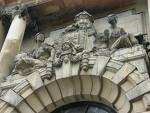 George Fearon M.D. M.R.C.S. (14 August 1817 – 10 December 1860) was a British orthodox physician who converted to homeopathy and who was the first homeopath to practice in Birmingham at the Birmingham Homeopathic Dispensary, and whose efforts raised the finances for the Midland Homeopathic Hospital.
George Fearon M.D. M.R.C.S. (14 August 1817 – 10 December 1860) was a British orthodox physician who converted to homeopathy and who was the first homeopath to practice in Birmingham at the Birmingham Homeopathic Dispensary, and whose efforts raised the finances for the Midland Homeopathic Hospital.
Fearon was a committee member of the Association for the Protection of Homeopathic Students and Practitioners. He was also a member of the Hahnemann Publishing Society and was elected joint secretary, along with John Mason Galloway, for the British Homeopathic Congress held in Birmingham in August, 1858.
Fearon was a colleague of William Vallancy Drury, John Epps, John Mason Galloway, George Stevenson Knowles, Joseph Laurie, Joseph Lawrence, William Parsons, George Wyld, and many others.
Fearon was also on the Medical Council of the Hahnemann Hospital at 39 Bloomsbury Square.
Fearon Practiced at 31 Great Charles Street and at 9 Calthorpe Street Birmingham.
Fearon was born in Clarendon, Jamaica, the son of planter William Wheeler Fearon (c.1791 – 1838) and Angelina Israel Christian (1796 – 1819)
Fearon was born in Jamaica, and he travelled to England for his education. In 1838, he travelled to Paris where he met Samuel Hahnemann and converted to homeopathy. On his return to Edinburgh, he was refused his degree due to his conversion to homeopathy, but he managed to obtain his medical diploma from Giessen.
Thomas Hayle was born at Fearon’s Place in Clarendon, Jamaica, in December 1808, the son of Dr. William Pusey Hayle (1759 – 1823) and his second wife, Frances Bryan Fearon (1772 – 1813). Frances Fearon was aunt to Birmingham homeopath Dr. George Fearon.
Hayle purchased a private practice at Deddington, Oxfordshire. In 1840 he was visited by his cousin, Dr. George Fearon, who gave him a copy of Hahnemann‘s Organon of Medicine and persuaded him to investigate. Hayle conducted extensive research and within the year had become a convert to homeopathic medicine.
Add in this bio and link to Dr. Berry King.
Was he ever member British Homeopathic Society ? In 1850 he is among the names of medical homeopaths without affiliation to either The British Homeopathic Society or the English Homoeopathic Association.
The same year, 1850, Fearon was one of the subscribers for the new London Homoeopathic Hospital.
MD Edin 1838, MRSCE Giessen 1840,
The Association for the Protection of Homeopathic Practitioners and Students was Founded in 1851, members included George Atkin, Francis Black, John Chapman, Paul Francois Curie, John James Drysdale, Robert Ellis Dudgeon, Fearon, Edward Hamilton, William Hering, C B Kerr, Joseph Laurie, John Ozanne, John Rutherford Russell, David Wilson and many others.
Subsequently, in 1844 Evelyn Philip Shirley MP employed Fearon to homeopathically treat the tenantry on his estates in Ireland, where Fearon saw over 100 patients a day, a position so arduous that he eventually succumbed to typhus, which he treated himself homeopathically, refusing to consult an allopath.
Fearon returned to England in 1845, settling in Birmingham where he set up a dispensary for the Poor and worked there single handedly for over 16 years, but thereafter, others came to assist him. The Birmingham Homeopathic Dispensary was set up in 1845, and in 1848, it moved to Old Square. The Dispensary work enabled a fund to be set up to finance the Birmingham Homeopathic Hospital, later renamed the Midland Homeopathic Hospital, which Fearon lived long enough to see accomplished in 1859.
On 16 October 1855, Fearon was one of the primarily midlands-based attendees at the Conference of Homoeopathic Medical Practitioners, held at the Queen’s Hotel in Birmingham.
Fearon died of overwork and ill health aged 45.
Fearon’s Obituary is in The British Journal of Homeopathy, and in the British Homeopathic Review in 1861, responded to by John Epps.
George Fearon wrote Evidences in favour of the homoeopathic system of medicine, and he submitted articles and cases to various homeopathic publications. George Fearon was well loved in Birmingham, and the local newspaper, the Aris’s Gazette, published some of his letters. Fearon was also internationally acclaimed, and his works and deeds were published widely in Europe and America.


Leave A Comment